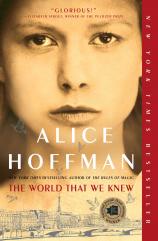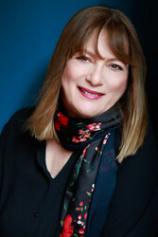The World That We Knew
Review
The World That We Knew
Jewish by birth, I was brought up defiantly secular, with no sense of formal religion or cultural heritage. This was freeing but also a recipe for ignorance. It wasn’t until I read Anne Frank’s diary that I grasped what my fate would have been had my fortunate middle-class adolescent life been transposed to Holland in the early 1940s: hiding with my family in an attic space, then dying in a concentration camp.
It’s exactly this transition --- from a safe, settled existence to one of terror and imminent death --- that Alice Hoffman addresses in her latest book, THE WORLD THAT WE KNEW. When a novelist tackles the Holocaust, often the tools of fiction seem inadequate. But Hoffman is a genre all her own. Her work dwells in the mysterious territory between fact and myth, human and supernatural, science and sorcery. (My personal favorites include ILLUMINATION NIGHT, AT RISK, PRACTICAL MAGIC and its sequel, THE RULES OF MAGIC.) Her characteristic mix of realism and fantasy is strangely apt for a horror that is almost beyond description, enabling her to tell a story of pure evil, unfathomable loss and miraculous survival. Often I read it through tears, struck by the radiance of her writing and the sincerity of her purpose.
THE WORLD THAT WE KNEW begins in Berlin in 1941, where “demons were on the streets” --- demons who looked like young men in brown uniforms. When Lea, a Jewish girl of 12, is attacked by a Nazi soldier, her fiercely protective mother resolves to send her to safety in the home of a French cousin. But not alone. She prevails on 17-year-old Ettie, a rebellious rabbi’s daughter who has secretly observed her father’s sacred rituals, to create a golem --- a supernatural creature with its roots in Jewish folklore and mystical tradition --- to guard Lea on her journey. There are echoes here, of course, of Mary Shelley’s Frankenstein monster, but Ava, the golem, is female, and valiant rather than frightening.
"[Hoffman's] characteristic mix of realism and fantasy is strangely apt for a horror that is almost beyond description, enabling her to tell a story of pure evil, unfathomable loss and miraculous survival. Often I read it through tears, struck by the radiance of her writing and the sincerity of her purpose."
On one level, then, THE WORLD THAT WE KNEW is a sort of horror story-cum-folk tale, its protagonist a creature who “sees the world beyond men’s eyes.” To Ava, angels and demons are visible; she speaks the language of birds and animals and insects; she is “stronger than a hundred horsemen”; she can tell the future. Ultimately, she falls in love with a beautiful heron, nearly as tall as a man, who saw Ava “for who she was. A creature like no other.” The passages told from the golem’s point of view are to me the most unusual, gorgeously written part of the story.
On another level, though, this is a historical novel, a tale of survival and love. Ettie, Ava’s creator, also leaves Berlin for France, accompanied by her sister, but their false papers don’t pass muster, and the sister is shot when they try to escape. Determined to avenge her, Ettie joins the French resistance. Lea and Ava, meanwhile, arrive in Paris. The cousin’s family includes two sons --- Julien, the younger, is drawn to Lea; Victor, his older brother, to Marianne, the maid.
But when the Nazis occupy Paris and start rounding up Jews for slaughter, Lea and Ava, as well as the boys, must run for their lives. Marianne has already returned to her father’s farm in southeastern France, near the Swiss border, and this region is where all six major characters converge. Victor and Ettie become forgers, assassins, saboteurs; Marianne guides refugee children through the mountains to safety in Switzerland; Lea and Julien, too young to fight, rely on the kindness of strangers, and on Ava and the heron, to stay alive and connected.
All this is based on extensive research, but the historical background, to my mind, isn’t well integrated into the narrative. Often it materializes in large, intrusive chunks that weigh down the gripping story. Hoffman’s intention, I’m sure, is to show that French collaboration with the Nazis was balanced by an organized resistance as well as by ordinary heroes who hid Jews and helped them escape. Perhaps her imaginative powers were trammeled by her determination to document and honor the courage of these selfless souls.
Hoffman is much more successful when she lets the past speak through her characters. These formerly sheltered adolescents, now beleaguered orphans, turn into passionate adults before our eyes. Victor and Marianne, though in extreme danger from their work, find love; Lea and Julien, separated for most of the book, discover, with Ava’s help, a transcendent way to communicate; when the heron is not migrating south for the winter, he and Ava carry on a strange romantic dance.
A point of crisis comes at the conclusion of THE WORLD THAT WE KNEW. It’s 1944; the war is ending, and Lea and Julien are about to escape into Switzerland. But what about Ava? The longer golems stay alive, according to tradition, the more powerful and potentially destructive they become. Thus, before she left Berlin, Lea was told by her mother that once she is safe, she must kill her protector.
But Ava has evolved, becoming more human by the day as her bond with the heron deepens and her duty to Lea, whom she was created to protect, becomes more an act of love than a burden: “Even though she was water and clay, she was between worlds, more than her maker ever imagined she would be. Perhaps love had done this to her….” In the final pages, Lea and Ava confront the angel of death and face a heartbreaking choice.
The key to THE WORLD THAT WE KNEW, I think, is alchemy: the literal alchemy of clay and water and ritual that produces Ava, and the figurative kind that melds scientific learning and spiritual wisdom. Lea’s father was a medical man; the father of the French boys, Julien and Victor, a mathematician, Ettie’s, a rabbi. And the individuals the young people encounter in their struggle to resist and survive --- a mother superior, a pastor, a doctor, an artist, a beekeeper who is never stung --- epitomize the powerful fusion of these elements.
Rationality alone cannot fight wickedness, says Lea’s mother at one point; “magic and faith were needed.” I think that’s always been Alice Hoffman’s belief, too, brought to luminous realization in this book.
Reviewed by Katherine B. Weissman on September 26, 2019
The World That We Knew
- Publication Date: September 1, 2020
- Genres: Fiction, Historical Fiction, Magical Realism
- Paperback: 400 pages
- Publisher: Simon & Schuster
- ISBN-10: 1501137581
- ISBN-13: 9781501137587




